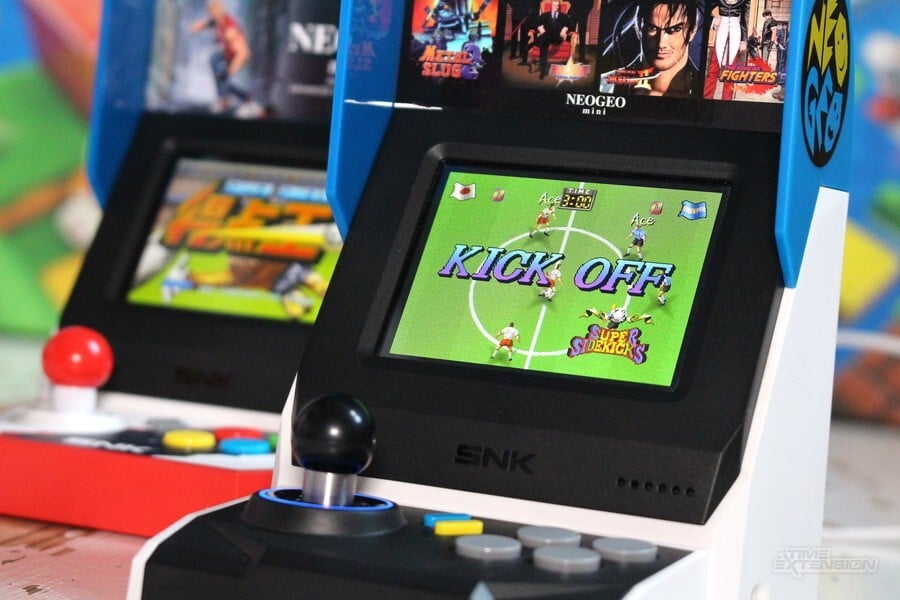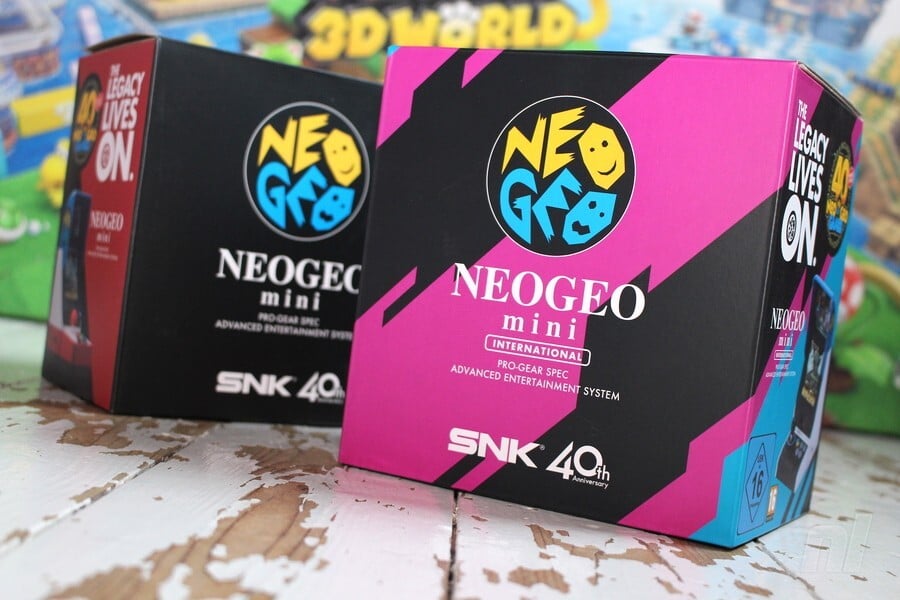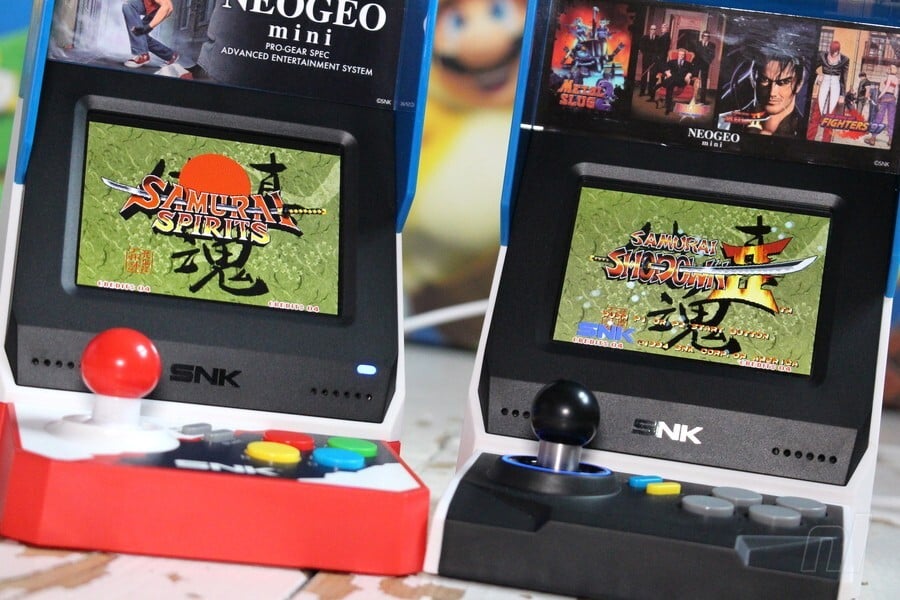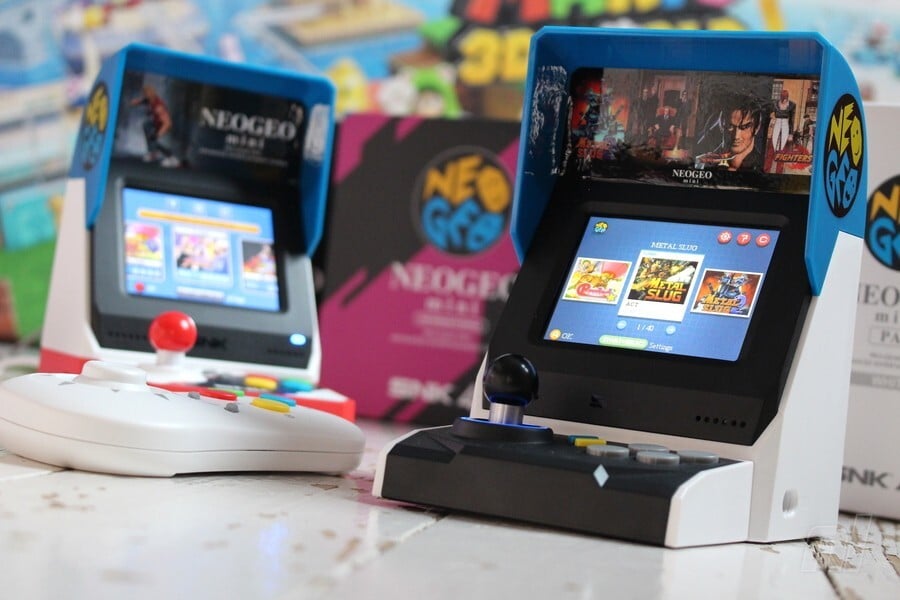
The 'classic console' market is getting pretty busy right now, what with the NES Classic, SNES Classic and PlayStation Classic sure to keep the tills ticking over this Christmas, and the Mega Drive Mini to look forward to next year. SNK is another company that has entered this niche but profitable arena; earlier this year, we went hands-on with the Japanese version of the Neo Geo Mini, a tiny arcade cabinet-style system which featured 40 classic titles and could plug into your TV for the full console experience.
Strangely, SNK didn't feel that a single Neo Geo Mini unit would be suitable for global consumption and quickly announced that a second machine – with a different software line-up and a modified case design – would be made available to buyers outside of Japan. We've now been able to secure a review unit of this model, and while we'll perhaps stop short of analysing it quite as deeply as we did the Japanese edition, we'll nevertheless aim to tell you if this more readily-obtainable version is worthy of your cold, hard cash.
Neo Geo Mini International Edition Review: The Hardware

First things first, the international version of the Neo Geo Mini is a slightly different beast when it comes to pure aesthetics. The Japanese model had a bright and eye-catching colour scheme, mixing white, red, blue and black to good effect. It also came with a sticker which could be applied (painstakingly, we might add) to the control panel for an even more appealing look. Compared to this version, the international model is rather dull; the marquee is still blue and has the Neo Geo logo on either side, but the main bodywork is now purely black and white. Why SNK has opted for this more austere colour scheme for the global version is anyone's guess; what makes the choice all the more confusing is the fact that the packaging is much more vibrant and colourful than what the Japanese edition ships in.
It's also worth noting that the control area of the unit has undergone some changes too. The control panel has a different shape (and comes without the option of fitting a sticker) while the shaft of the joystick has a metal cover; on the Japanese version, it is entirely plastic. The final big change is that the blue power LED that sat below the screen on the Japanese model has vanished, and instead the base of the joystick is illuminated to show when the machine is turned on. We have to admit, we vastly prefer this to the Japanese original; it looks seriously cool.
The controllers that are available alongside the system are identical to those that launched in Japan, and connect via the two USB Type-C ports situated on either side of the machine. They're based on the iconic Neo Geo CD pad but the button placement has been changed; it's also worth noting that the directional pad is not micro-switched. This has caused some consternation among hardcore SNK fans and while it's arguably less precise to use (and doesn't feel quite right, either), we can understand why this decision has been made from a production standpoint – the micro-switches inside the original Neo Geo pad didn't have a very long lifespan.
The LCD screen on the console is fantastic and has the exact same 320x224 pixel resolution of the original Neo Geo hardware. As a result, everything looks pin-sharp and there's no unsightly blurring of pixels. Sadly, things aren't quite as appealing when you plug the console into your TV using a HDMI cable (not included in the box, we should add); everything looks soupy and fuzzy, and the optional image enhancement setting simply applies an emulator-style pixel-smoothing filter over the top, which is somehow even worse. From a distance, the Neo Geo Mini doesn't look too bad on your big-screen telly, but it's a real shame that SNK couldn't match the image quality generated by the NES and SNES Classic Editions.
Neo Geo Mini International Edition Review: The Games

Outside of the aforementioned hardware changes, the 40 games that come pre-installed on the console are slightly different on the international version. While the Japanese model was keen to highlight SNK's proud fighting game heritage, this global edition offers a wider selection of genres and is perhaps a more 'balanced' offering, as it doesn't rely so much on you being a rabid fan of one-on-one brawlers.
Here's the complete line-up:
- 3 Count Bout
- Art of Fighting
- Blazing Star
- Blue’s Journey
- Crossed Swords
- Fatal Fury Special
- Foot Ball Frenzy
- Garou: Mark of the Wolves
- Ghost Pilots
- King of the Monsters
- King of the Monsters 2
- Kizuna Encounter: Super Tag Battle
- Last Resort
- Magician Lord
- Metal Slug
- Metal Slug 2
- Metal Slug 3
- Metal Slug 4
- Metal Slug 5
- Metal Slug X
- Mutation Nation
- Ninja Master’s: Haou Ninpou Chou
- Puzzled
- Real Bout: Fatal Fury
- Robo Army
- Samurai Shodown II
- Samurai Shodown IV: Amakusa’s Revenge
- Samurai Shodown V Special
- Sengoku 3
- Shock Troopers
- Shock Troopers: 2nd Squad
- Super Sidekicks
- The King of Fighters ’95
- The King of Fighters ’97
- The King of Fighters ’98
- The King of Fighters 2000
- The King of Fighters 2002
- The Last Blade 2
- Top Player’s Golf
- World Heroes Perfect
Having the entire Neo Geo Metal Slug series is a massive bonus which will make this particular edition appealing to seasoned SNK fans, and games like Crossed Swords, Robo Army, Magician Lord, Last Resort, Ghost Pilots, Mutation Nation and 3 Count Bout – while not what you'd call essential – offer a much better view of the Neo Geo's library than the fighting-focused Japanese version. Of course, the model you ultimately opt for will be based on your personal taste in games, but it's rather maddening that SNK has given us two different selections. To confuse matters further, a special Christmas edition of the system is also on the way which offers a third line-up of titles, although there is naturally a lot of overlap between all three units.
Neo Geo Mini International Edition Review: The Verdict

While it may seem like there's little difference between this model and the Japanese original, the revised case design and slightly different software line-up mean that there's actually a lot to mull over before making a purchase. If you're a fan of SNK's fighting games and like your mini-consoles to be bright and colourful, then the Japanese edition is the one to go for. However, if you don't mind a more understated design and want to sample a wider range of genres, this international version is by far the better choice – and you've got the added bonus of being able to order it domestically, too.
Tricky region-based decisions aside, there's no denying that the Neo Geo Mini is something of a rough gem; on the plus side, the LCD screen is fabulous and the selection of games is fantastic, but the quality of the image generated via the HDMI cable is annoyingly poor. It's also a shame that an internal battery wasn't included, as it would make the unit a little more portable. Ultimately, it's not perfect, but we can't help but love this dinky little arcade machine, and if like us, you recall when SNK's prohibitively-expensive console was first released, the prospect of being able to own a mini version with 40 games without having to sell any of your vital organs is something we're not sure we'll ever grow accustomed to.
This article was originally published by nintendolife.com on Wed 28th November, 2018.







Comments 26
Great review, thanks. I note the pricing on the International Edition has got keener since release, and even since I placed my order after I noticed the first drop. Those bundles are quite good.
wonders what the Mayflash Controller adapter is...
Oh, that's what it is. Possibly a good alternative to me buying a second Neo Geo controller pad... assuming it works with the WiiUPro/SwitchPro/8bitdo pads.
Sounds like, overall, they've done a pretty good job with this. I'm not a big enough fan of the Neo Geo to justify putting down that much cash... but, for those that do, it looks like a really cool product. Enjoy!
I seriously don't see how this review defends SNK's choice for no micro switches in the controllers. Micro switches today are much better than they we're in the 90's, this choice was made out of pure greed base on their response "clicky thumbsticks cost too much". The emulation is pretty good but the filter they put on the video out still boggles my mind and the no scan line option is also weird. This console with 2 controllers and an HDMI mini cable almost costs $200 which is what a PS4 cost! The only thing SNK hasn't changed are their ways for charging way too much money.
I got the international just because it is cheaper and easier, but it is honestly kind of a novelty console for me. I have pretty much all the ACA games on the Switch as well as the Hori arcade stick for the Switch which is by far the best way to play these games. Problem with that is how the arcade stick alone costs more than the entire Neo Geo Mini and the games can really add up over time. Personally I don't mind because I always wanted to collect Neo Geo games but I couldn't justify the cost of buying the original hardware and games off Ebay, and despite how it can be a little pricey to have this setup on the Switch it is a fantastic bargain in comparison.
It is also worth noting how the ACA Neo Geo games for Switch are definitely superior versions of these games in comparison to what you get with the Neo Geo Mini. My biggest complaint about the Neo Geo Mini is how you are getting the AES home system ports without any ability to customize them in terms of difficulty, credits, censorship, and so on (although there is a few exceptions when it comes to difficulty), and most of the games are censored. With the ACA Switch games you have a full range of options for customization, you can disable censorship, and there is a much better selection.
I was hoping to get the christmas one, you know for christmas but they aren't leaving a lot of time to order one.
I’m satisfied with getting the Neo Geo games on Switch. And I als have the Hori Arcade stick. But, are there going to be reviews for the Neo Geos games released on the Switch? I haven’t seen any in awhile.
its fun and my kids love playing on it as well. just need a hack to make it better
Ohh, now do the Christmas edition.
The lack of micro switches (my original Neo Geo CD pad still works just fine in 2018) and the dodgy video output is enough to stop me from buying this. Shame.
@JayJ Censored? So, what am I supposed to expect, then? White blood/sweat in Metal Slug and so on?
Odd that this wasn't mentioned in the review, especially since this is supposed to be a mini version of the Neo Geo Arcade cabinet, and not a Home cabinet.
@tguk911 Except that PS4 doesn't come with 40 games included...
But in all seriousness: I agree with you on the joypads and the lack of a good scan line filter, but other than that, it's still very reasonably priced for what you get for your money, considering the current worth of the individual games included, even on today's consoles.
@hatch you put a sanwa joystick into the 8bitdo arcade stick? I think I saw a YouTube video about this but I thought it might be expensive to buy the ge uube Japanese sanwa parts plus the 8bitdo? If you have a link or can suggest a website would be happy to hear where you got the parts?
Do you know how your sanwa mod compares got he hori stick for the switch? I think those are quite expensive.
I own the international version, and it's cool for what it is, a novelty desktop arcade machine. Don't know why anyone would bother plugging this into a TV though; if you want to do that just buy the Switch versions and use a pro controller.
@hatch
You kind of need to solder the wires to put a Sanwa stick in, I say kind of because you can use a terminal block but the connections are not as secure and movement over time can cause the wire to slip out. That being said I modded my 8bitdo with all sanwa parts and it's a great investment.
@ThanosReXXX
Yeah but theres no way some novelty toy should even approach these prices. I mean you can buy one of those Pandoras boxes for that much which comes with over like 2000 games.
@tguk911 So, do you find the Nintendo Classic Minis also far too expensive, then? I hope not, because besides the few obvious improvements these offer over the Neo Geo Mini, they aren't all that different.
And the Neo Geo Mini has an LCD screen, and doesn't need a TV to operate, so there's that. And again: it's a whole bunch of games PLUS a complete, self-contained system to play them on.
These titles on their own are on average $6 a piece in Nintendo's eShop, so that times 40 is worth the price of it all by itself already.
As for the Pandora Box: do you mean this crappy thing?
https://sc02.alicdn.com/kf/HTB1WxPAHKOSBuNjy0Fdq6zDnVXah/Pandoras-Box-Bartop-Console-Arcade-Board-Video.jpg
Lots of questionable stuff on there, cheap, ugly design, and considering the manufacturer, I'd put them on the same level as AtGames, so regardless of the greater number of games, I'd hardly consider it a better deal as a product that's actually the real deal...
These ones look nice, though:
https://arcademachine.en.alibaba.com/product/60642692725-804431451/19_inch_2_player_pandora_box_645_in_1_mini_coin_operated_arcade_bartop_game_machine.html?spm=a2700.details.pronpeci14.2.6d563633fQVfjL
But you do have to buy one of these separate arcade boards for them:
https://www.alibaba.com/product-detail/jamma-HDMI-pandora-s-box-4s_60667886466.html?spm=a2700.7724857.normalList.21.30d047b1M8leuM
@hatch thanks very much. Aus and Canadian dollars are very close so I buy lots of gaming relates things from Canada, Video Games Plus is great.
@tguk911 I'm not worried about soldering, I would prefer it as you say, to avoid loose wires over time. The biggest problem is dremeling out plastic, so if not required for 8bitdo sanwa conversion I'm sold!
No I think Nintendo did an amazing job on the minis. Also the LCD screen is the best part about the Neo Geo mini in that it actually looks good to play. Also the Pandoras boxes can play most of what the neo geo mini offers just fine, the neo geo mini is running a chipset thats found on $20 android tablets. I think you missed my entire point though I'm not comparing the actual products to eachother it was more of a response to you saying the neo geo mini has games over the ps4 for that price point. Also the Neo Geo games on switch can't be compared since they needed to be ported which a lot of that price comes from and is a much superior way to play these games than on the Neo Geo mini. Like I said the Neo Geo mini is fine as a novelty product or for casual gamers but they let down the SNK community as a whole and I don't think the price point is worth it. I still bought the int and jp versions but SNK could've done a lot better job.
@bolt05
Yeah no need to do anything like that just need to solder some wires to the sanwa harness and your good to go. You could also get a cherry modded sanwa which wouldn't require soldering which has quick connect terminals.
@ThanosReXXX Yeah it is kinda odd how the don't mention it, but I can definitely confirm how it's there. If you play Metal Slug on one of these the blood is all white for example.
@tguk911 thanks for the tip.
This screams "wait for an updated version", so I will.
I probably missed it and I'm sorry but where can I get this in canada?
@JayJ Ah, that's a shame. Well, I'll wait and see if some YouTuber is going to find out if these are hackable then, so I can put my own games on it, WITH red blood...
I'm enjoying mine tons - genuinely impressed and am now a huge fan of ADK's early Neo Geo releases that I discovered thanks to this machine.
That said, I have not ever been spoiled by any pre-exposure to any "real" Neo Geo hardware. Nevertheless, both the controllers and cabinet are built very well, shame about the so-so HDMI output quality, but for me it's good enough.
Tap here to load 26 comments
Leave A Comment
Hold on there, you need to login to post a comment...